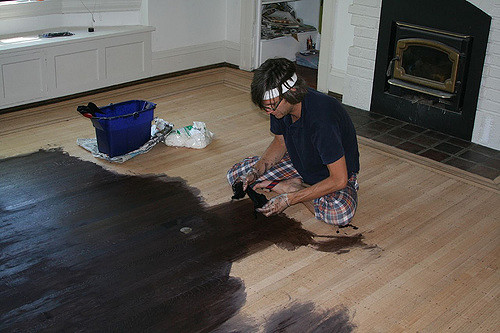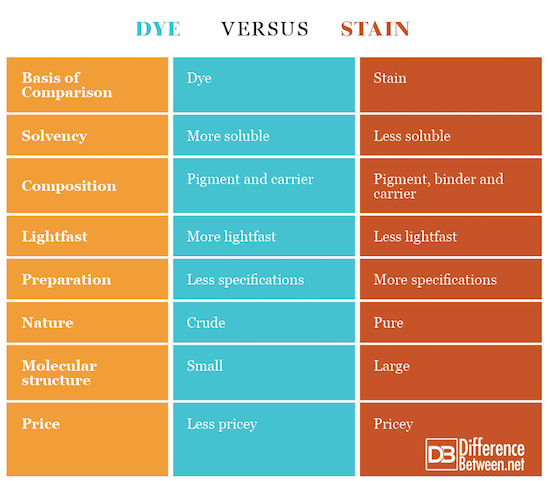Difference Between Dye and Stain
Dye Vs. Stain
Dyes and stains are colouring agents used in the textile industry, with biological specimen, concrete coloring and woodwork. To the majority, both dyes and stains are one and the same product. As a result, the terms are used incorrectly and interchangeably. Despite both being similar in appearance and in use, the similarity ends right there. They have different properties that result in contrasting performance and characteristics.
Dyes are lighter and are made up of smaller sized molecules which make its composition soluble, stains are larger in size which makes its composition less soluble. They are both used for similar coloring purposes, but the characteristics of each determine the end result.
What is a Dye?
A dye is a colorant that is mixed in oils like mineral spirits, in alcohol or water as a carrier. The dyes that are used in wood as quite similar to those used in dying clothes and different materials. Dyes are naturally transparent and bring color changes in the wood without necessarily altering the figure. Dyes are made of small molecules that are permeable enough to let light pass through unhindered.
Research states that water-based dyes are more light-fast than the alcohol-based ones. The oil-based are reported to fade faster than the other two. So if you are trying to choose between the options, choose the water-based if your determining factor is durability. Alcohol based dyes when mixed with shellac or lacquer are the best to make shaders.
What is a Stain?
Stains can be generally referred to as thin water or oil based paints. Stains are made of larger molecules that are less soluble when compared to dyes. As a result, you will be required to stir the component frequently when in use, as the pigmentation often settles at the bottom of the package. They are classified into three categories: acid, penetrating and the film-forming. Stains are available in different colors, shades, tints and textures and different technology is uses to create each of the three categories listed.
The oldest of the three types are the film-forming which have existed for close to a century and are the most popular type of stain. Despite being the most popular type of stain, they are the least durable. Over time due to weather, chemicals and other elements, the layers often peel, fad or flake.
Penetrating stains are a more permanent alternative to the film forming type. This form of stain is specially designed to penetrate deeply into the pores of the surface and bond with the top layer. They use a water based polymer bonding technology that minimizes the chances of fading, flaking or peeling. This type of stain is also available in almost all shades and colors from the light translucent types to the bold solid tints. They are more user friendly and one can easily mix up different shades to create new colours, (just as you would with the regular wall paint). However, this stain type is translucent and doesn’t hide the surface flaws and defects.
The last stain type, (acid stain), uses a totally different technology to create the color pigmentation. This stain type chemically reacts with the surface to create the natural-looking marble look by physically etching itself onto the surface. They are the most expensive and more durable of the two listed above, and also come with additional instructions and precautions to take due to its acidic nature.
Differences Between Dye and Stain
Solvency of Dye and Stain
Dyes are more soluble in different solvents. Some come in powder form and have instructions for the soluble to use, (water, acid or any other). Stains are not soluble they are made of huge particles that render them less soluble in solvents. Stains also require constant stirring due to this, as you will often find pigment chunks settled at the bottom.
Composition of Dye and Stain
Dyes are made of the dye pigment and a carrier. Stains are made of the pigment, a binder and the carrier.
Light-fast
Here lightfast refers to the property of a component not being prone to discolor under light exposure. Stains are much more lightfast than dyes.
Preparation of Dye and Stain
Dyes are made with less specifications and can contain many impurities. Stains are made under strict conditions, with greater care and are purer.
Nature
Dye is regarded as crude in nature. Stains are regarded to be pure in nature.
Molecular Structure of Dye and Stain
Dyes are made of small structured molecules while stains have larger molecules.
Price for Dye and Stain
Dyes are much cheaper than stains. However, this comparison is only applicable when analyzing products of a similar brand.
Dye vs. Stain: Comparison Chart
Summary of Dye vs. Stain
- Stains and dyes are colorants used in different industries and fields, (woodwork, concrete, biological and textile).
- They appear to be similar but the differences are distinct in the characteristics.
- Dyes are made of small molecules which makes it more soluble in solvents.
- Stains have larger molecules which renders it less soluble in the different solvents.
- Dyes are made of the pigments and the carrier, while stains have an additional binder.
- Stains have specific procedures in their preparation which contributes to its pure form.
- Dyes have no specific procedure in its preparation, hence it contains several impurities and is often referred to as crude.
- Stains are classified into three categories: acid, penetrating and the film-forming.
- Stains are more expensive than dyes.
- In terms of being lightfast, dyes take the lead.
- Difference Between S Corp and C Corp - September 9, 2018
- Difference Between Terrace and Balcony - September 9, 2018
- Difference Between Anabaptists and Evangelicals - August 31, 2018
Search DifferenceBetween.net :
Leave a Response
References :
[0]Image credit: https://www.flickr.com/photos/94693506@N00/687965115
[1]Image credit: https://en.wikipedia.org/wiki/Dyeing#/media/File:Indian_pigments.jpg
[2]Editors, C. P. (2004). Woodworking Tools & Techniques: An Introduction to Basic Woodworking. Quarto Publishing Group USA.
[3]Editors, C. P. (2005). Black and Decker The Complete Guide to Basic Woodworking: Skills and Projects Every Woodworker Needs. Quarto Publishing Group USA.
[4]Allen, M., & Forrester, P. (2006). The Complete Guide to Wood Finishes: How to Apply and Restore Lacquers, Polishes, Stains and Varnishes. Simon and Schuster.



